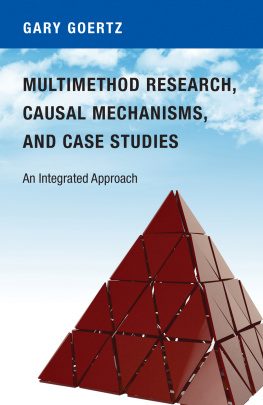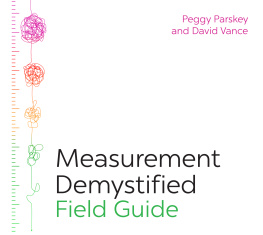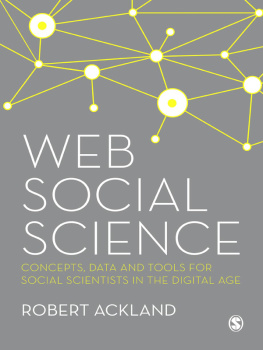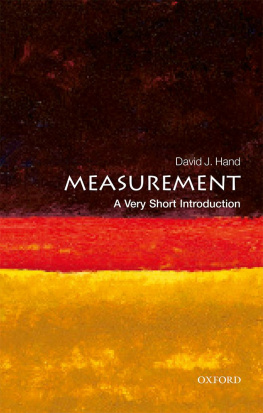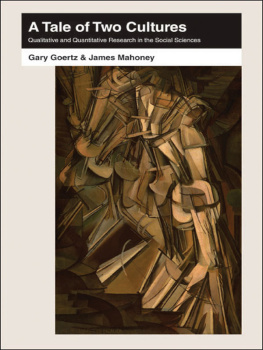SOCIAL SCIENCE CONCEPTS AND MEASUREMENT
Social Science Concepts and Measurement
NEW AND COMPLETELY REVISED EDITION
GARY GOERTZ
PRINCETON UNIVERSITY PRESS
PRINCETON & OXFORD
Copyright 2020 by Princeton University Press
Requests for permission to reproduce material from this work should be sent to Permissions, Princeton University Press
Published by Princeton University Press
41 William Street, Princeton, New Jersey 08540
In the United Kingdom: Princeton University Press
6 Oxford Street, Woodstock, Oxfordshire, OX20 1TR
press.princeton.edu
All Rights Reserved
Library of Congress Cataloging-in-Publication Data
Names: Goertz, Gary, 1953 author.
Title: Social science concepts and measurement / Gary Goertz.
Description: New and completely revised edition. | Princeton: Princeton University Press, 2020. | Revised edition of the authors Social science concepts, c2006. | Includes bibliographical references and index.
Identifiers: LCCN 2019056839 (print) | LCCN 2019056840 (ebook) | ISBN 9780691205489 (paperback) | ISBN 9780691205465 (hardback) | ISBN 9780691205472 (ebook)
Subjects: LCSH: Social sciencesResearch. | Qualitative research. | Political scienceResearch.
Classification: LCC H62.G575 2020 (print) | LCC H62 (ebook) | DDC 300.72dc23
LC record available at https://lccn.loc.gov/2019056839
LC ebook record available at https://lccn.loc.gov/2019056840
Version 1.0
British Library Cataloging-in-Publication Data is available
Editorial: Bridget Flannery-McCoy and Alena Chekanov
Production Editorial: Kathleen Cioffi
Cover Design: Pamela L. Schnitter
Production: Erin Suydam
Cover Credit: Joan Mir, Bleu II, 1961 Successi Mir / Artists Rights Society (ARS), New York / ADAGP, Paris 2020
CONTENTS
- vii
- ix
- xiii
- 1
- 26
- 67
- 98
- 136
- 163
- 192
- 215
- 244
- 272
- 299
- 311
TABLES
Concept structure and aggregation at the data level: MPI
A simple weakest link function
Systematic disagreement in the gray zone
Partially ordered typologies: a typology of autocratic regimes
Partially ordered typologies and statistical analysis: autocratic regime type and militarized disputes
Underlying row and column concepts and statistical analysis
Nominal typology or concept pair? Attributes of executive-legislative systems
Concepts with adjectives: nested concepts of revolution
FIGURES
Juggling conceptual balls
The basic three-level framework
Quality of life, OECD
Human well-being: SenNussbaum concept, basic and secondary-dimension levels
Consumption poverty
Polity concept and measure of democracy
Latent variable models: democracy
Two latent variable model of democracy
Indicators causing factors, MIMIC models: associations dimension of social capital
Concepts and ideal types: Polity democracy measure
Semantic transformations: transforming years of education to educated
Standard default semantic transformations: Polity democracy concept and measure
The semantics of not concepts: not-democracy
Poverty and wealth semantic transformations using World Bank categories and GDP per capita
Poverty and wealth semantic transformations: default categorization and linear transformation using World Bank categories and GDP per capita
Normative issues: privileging the very poor
The semantics of intensity-modifying adjectives: somewhat wealthy and very wealthy countries
Overlapping categories and semantic neighbors: autocracy, anocracy, and democracy
Distribution of countries by levels of raw and logged GNP per capita
Political Terror Scale: empirical cumulative distribution, 19762017
Political Terror Scale, repressive government: semantic transformation of an ordinal scale
Standardizing education according to the UNDP
The basic three-level framework: concept structure and aggregation
Weakest link concept structures and aggregation functions
Best shot concept structures and aggregation functions
Mean concept structures and aggregation functions
Three classes of concept structure: weakest link, mean, best shot
Variance and disagreement in the gray zone
Linear interpolation for the gray zone
Gray zone concepts: competitiveauthoritarian state
Standard typology methodologies: types of autocratic regimes
Intensionextension relationships: DemocracyDictatorship group concept of democracy, 19462008
Best shot to weakest link rules: DemocracyDictatorship group concept of democracy, 19462008
Nonstandard adjective semantics: the autocracydemocracy continuum
Intensionextension when a secondary-level dimension is absent (others present): DemocracyDictatorship data
Two-level theories: States and social revolutions
A two-level model of common pool resource institutions
A two-level model of the early modern roots of liberal democracy
A two-level model of the development of the social security state
Causal mechanisms and two-level theories: constraints on state exploitation
PREFACE
I WOULD LIKE to thank a wide range of individuals, institutions, and universities for feedback during the writing of this book. This volume has been in the works for years so it is impossible to remember all individuals and institutions that have contributed. This is a collective thank you to all.
I would like to thank all the students in my methods classes at Notre Dame over the years who have been subjected to various versions of this manuscript, as well as students at IQMR who have been test subjects for much of this material.
Particular thanks go to those who read the whole manuscript, including Barry Cooper, Sverine Deneulin, Carsten Schneider, and Richard Swedberg.
As always, thanks to Charles Ragin and Jim Mahoney for methodological inspiration and discussions over the years.
Various chapters of this manuscript in more final forms have been presented at several workshops and colloquia: thanks go to Simon Hug and Keith Krause at the University of Geneva; Zach Elkins, Pam Paxton, and John Gerring at UT-Austin; the QCA workshop in Antwerp 2019; James Copestake for organizing a couple of talks and a keynote at the University of Bath; and Ezequiel Gonzalez-Ocantos for organizing a talk at Oxford, as well as Colin Elman for a mini book workshop at IQMR in 2019.
Discussions with Eric Crahan at Princeton University Press got things going on the new edition of the book. Thanks to Bridget Flannery-McCoy and Alena Chekanov for managing the job in excellent fashion. Special thanks go to Alison Durham, who as copy-editor turned the raw materialstext, figures, and tablesinto a refined and polished product.
SOCIAL SCIENCE CONCEPTS AND MEASUREMENT
1
Introduction
AN ONTOLOGICAL-SEMANTIC APPROACH TO CONCEPTUALIZATION AND MEASUREMENT
To define a thing, is to select from among the whole of its properties those which shall be understood to be designated and declared by its name; the properties must be very well known to us before we can be competent to determine which of them are fittest to be chosen for this purpose.



